Tap Adjustment & Set for Panel Planes
For more information on planes, see our beginner site Common Woodworking.
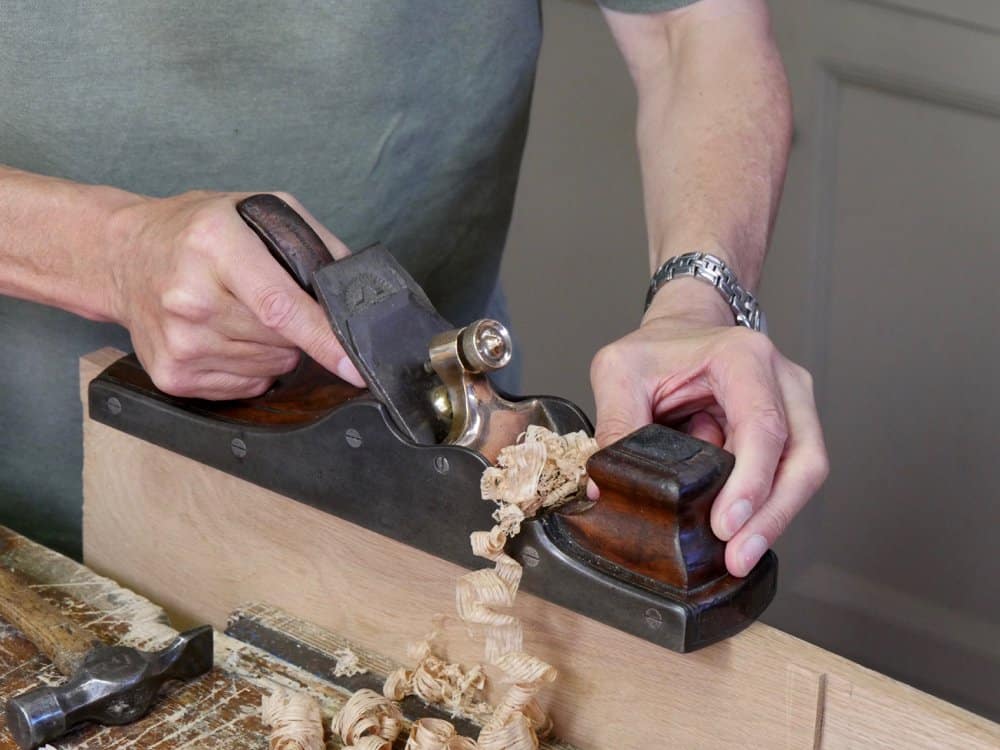
The panel plane I treasure here has no mechanical adjustment and relies on setting the depth of cut and blade alignment to the sole using simple and positive hammer taps. I know that many people, mostly engineers and such, might consider tap adjusting archaic and inaccurate, and I understand that, but really it’s far from that. As a boy I watched men tap the cutting iron to task using different points on the plane body and the cutting iron with a steel hammer. The size of hammer was inconsequential, but you do get used to favoured hammers for tasks like this.
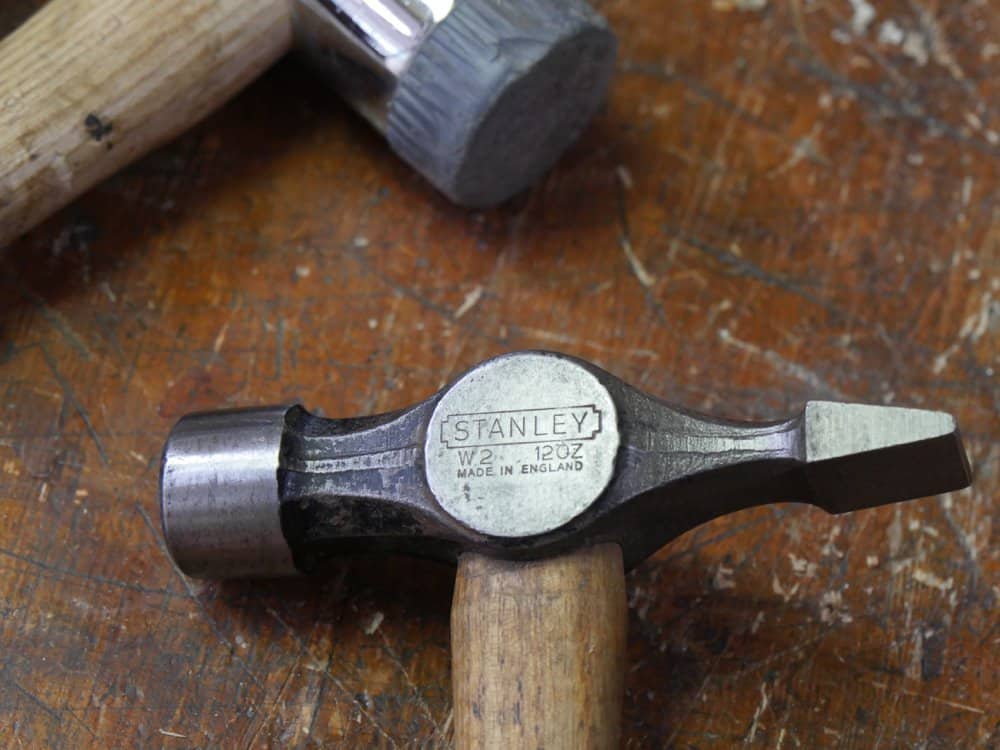
Mostly I use my Stanley Warrington hammer, which is 12 ounces, but to help preserve the plane bodies over a wider range of planes I pick up my Thorex 712 because it is the best hammer for body-shock blows to dislodge tightened wedges for cutting iron removal during sharpening.
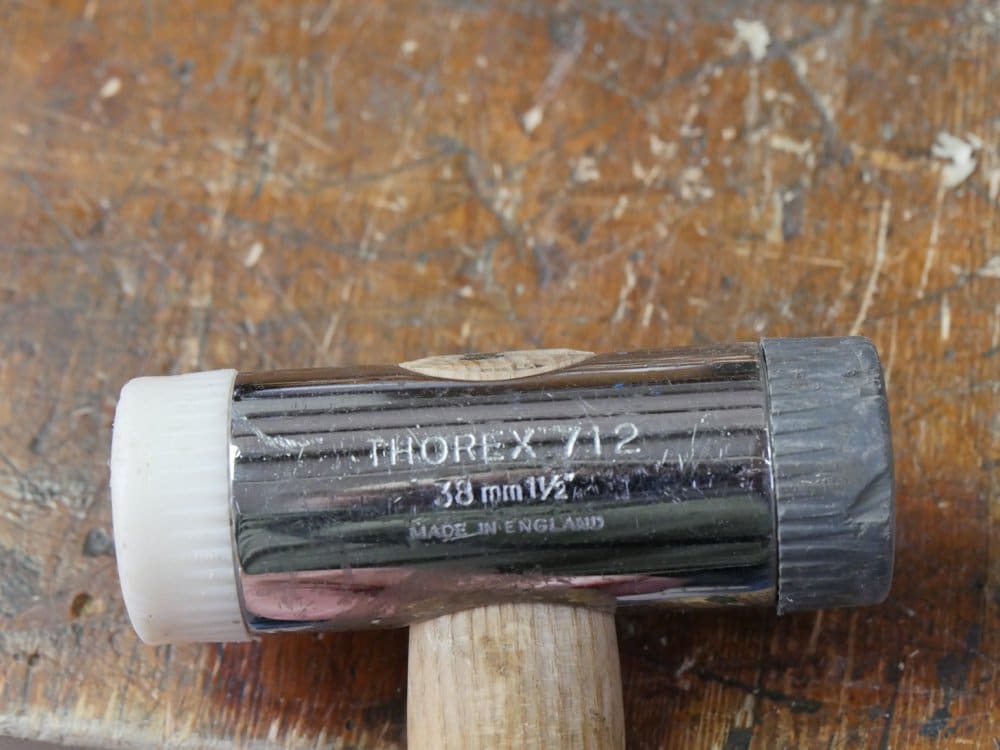
For bench planes that require compensation for blades that might not be sharpened exactly square the steel Warrington is excellent. It’s not fancy or costly and only careless use causes any kind of damage. I say this because the two hammers shown above should cost no more than say £25 for the two. Also, I have seen dedicated plane hammers being used but this is purely a preference some have rather than any kind of necessity. Between my two hammers I have everything I want and I also have two hammers that can do every task from forge work to hinge setting, nail driving to furniture assembly and all mallet work too. I certainly don’t think you need any special plane hammer as some advocate, unless of course you choose to buy one, which is fine. I think some to be very over priced and even a bit snobby too. That’s my view.
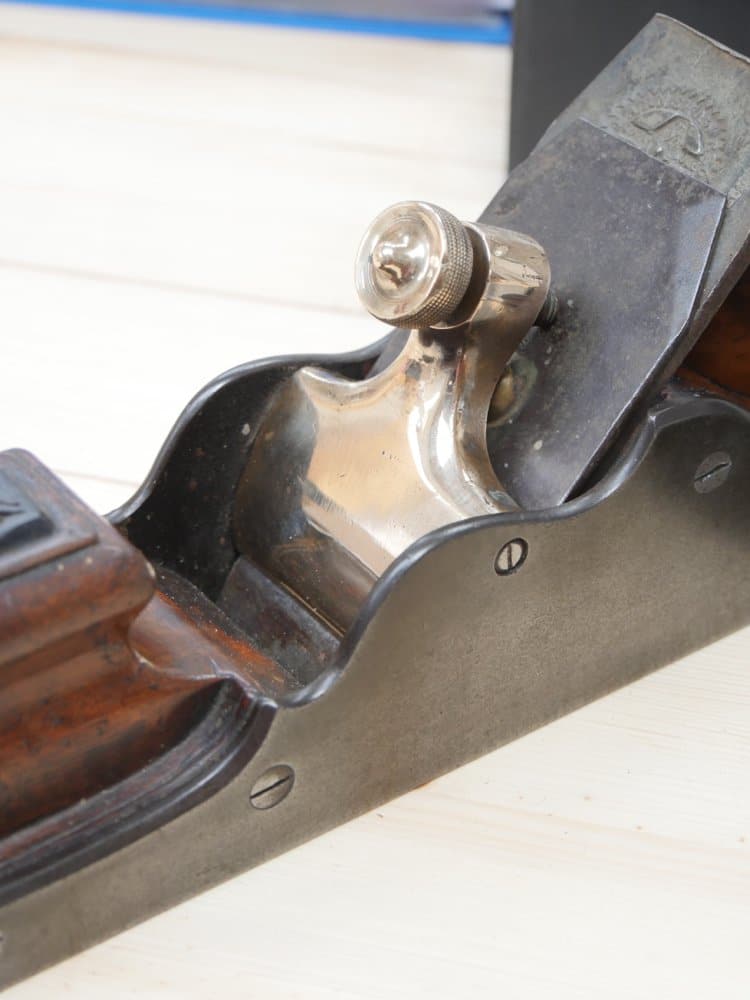
The securement for the iron is by leverage through the bulky bronze lever cap bridge crossing from one side-wing of the plane to the other. The knurled bolt passing through presses against the cap iron (chip breaker USA), which forces the fore edge of the bridge against the cap iron and the whole of the cutting iron assembly. Fingertips feel for the initial cutting edge in the throat of the plane as the bolt is cinched tight. All adjustment from now on is by tapping the plane at one part or another or tapping the iron itself.
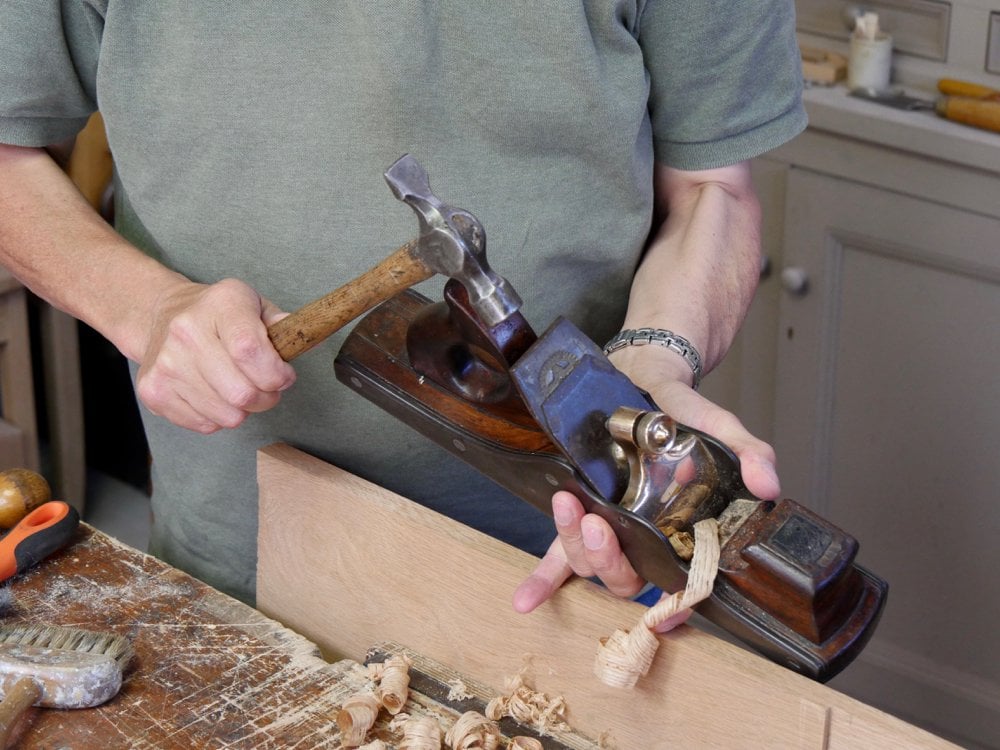
When the blade is secured in the plane, be that wedge or bridge securement, the plane iron is tapped on the top edge of the plane iron. This becomes a tap and try method whereby I tap the iron and place the plane to the wood to see if the plane iron is protruding through the mouth of the sole. Tap and try until it does.
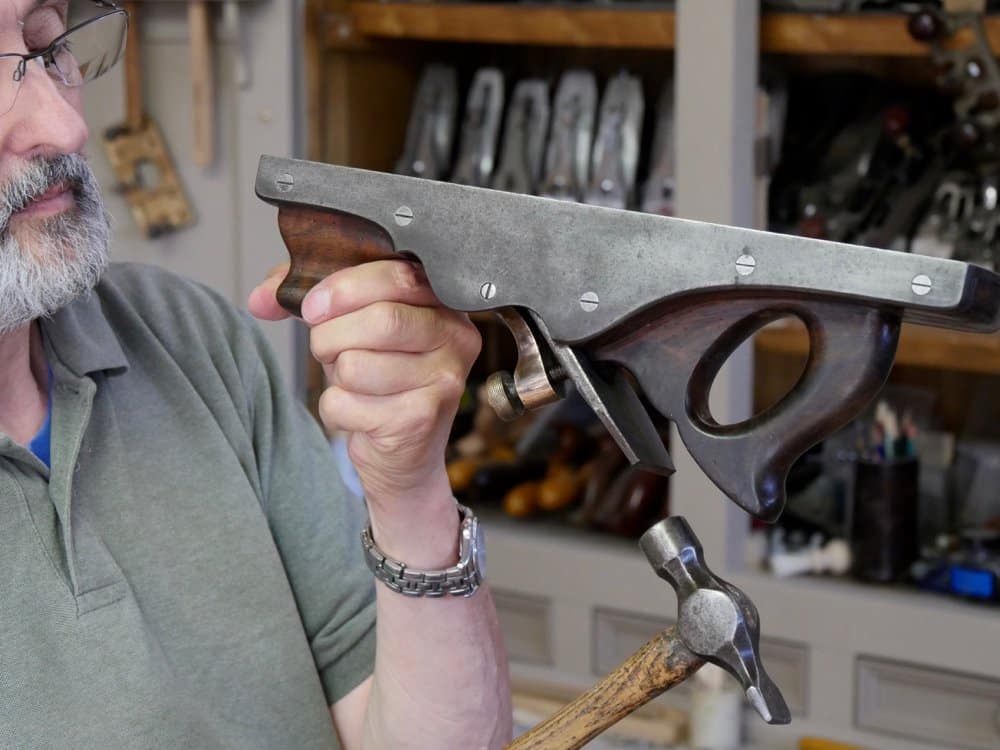
You really want a thin shaving and one that is even across the width of the plane sole as with other more modern planes. If it is even and you feel good about the shaving’s thickness then a quick check on the lockdown and you are good to go.
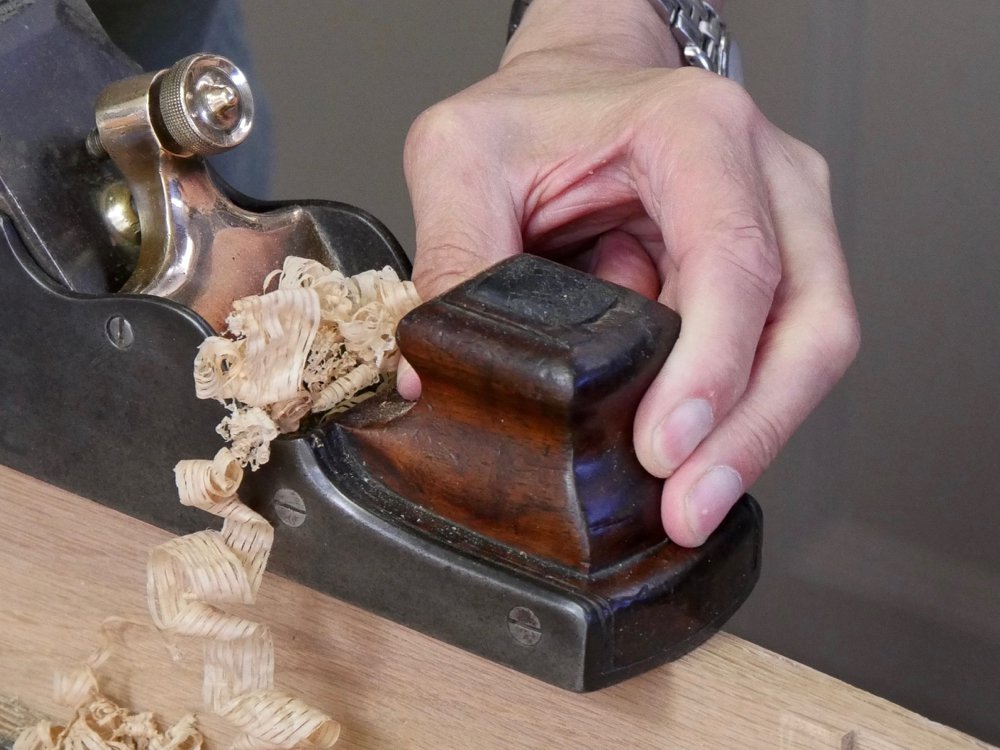
More likely the plane iron will be misaligned and the iron requires adjustment.
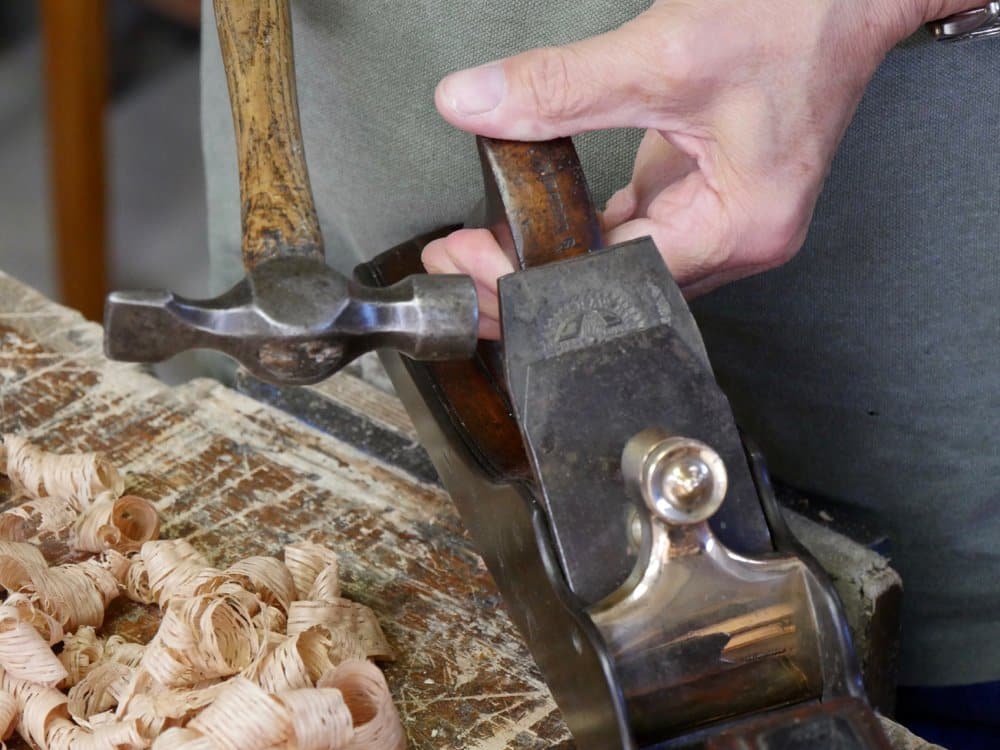
Look at the top area of the cutting iron and you will see the corners are not square but angled in. 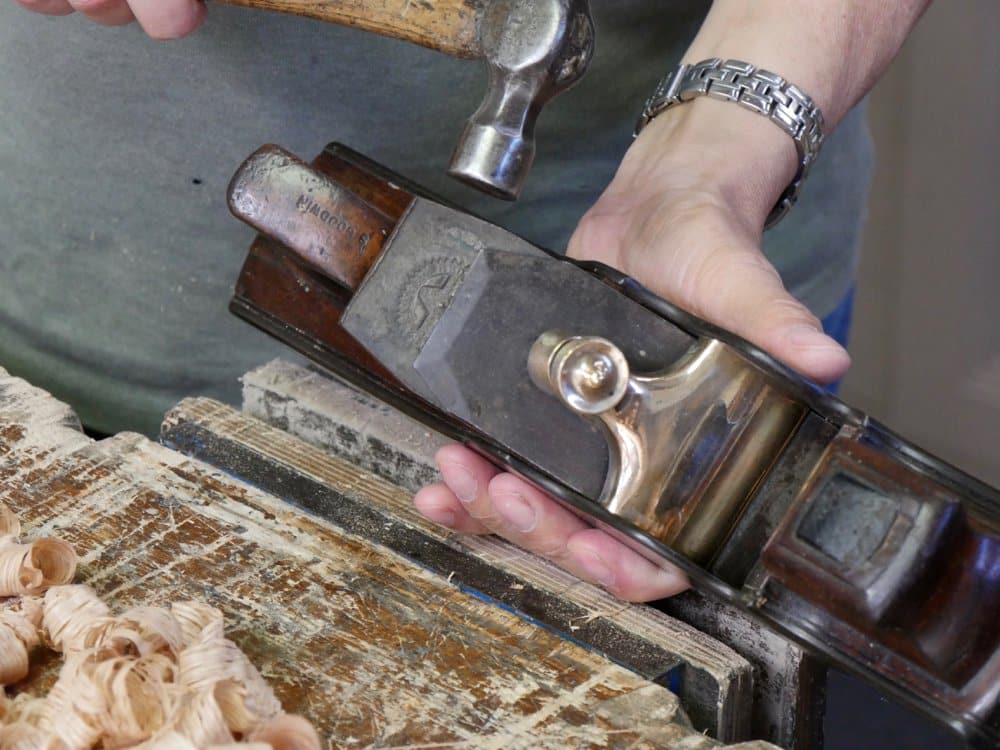
Withdrawing the iron back into the plane throat on panel planes is different than say all-wood bodied planes because wooden planes can be tapped in two places, the front knob and the heel or rear face of the plane. 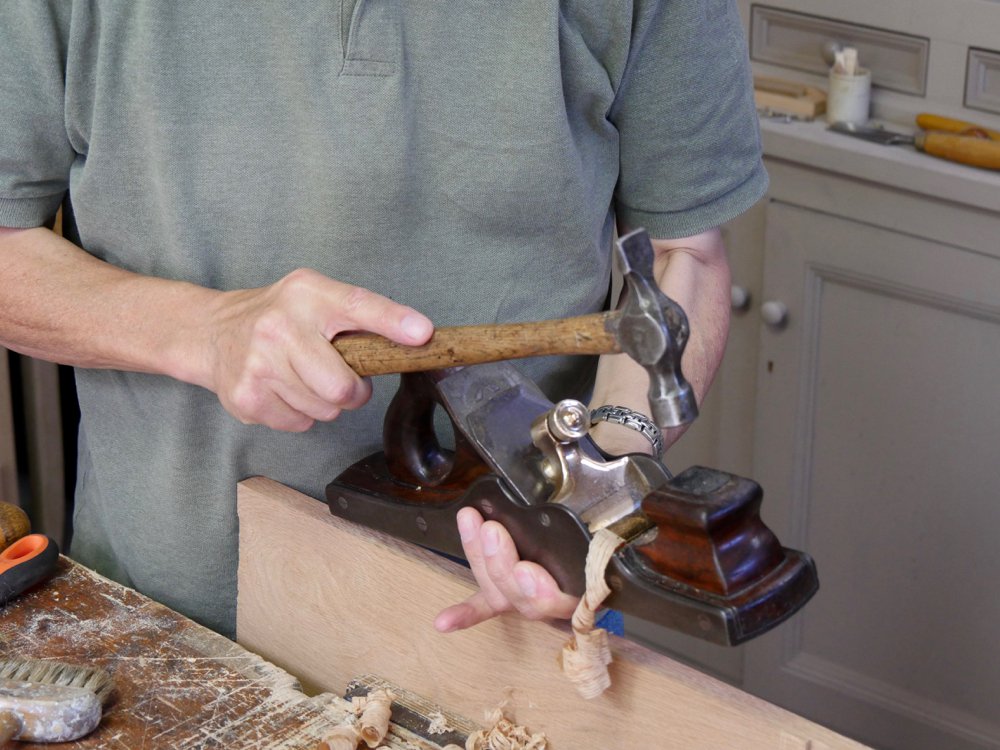
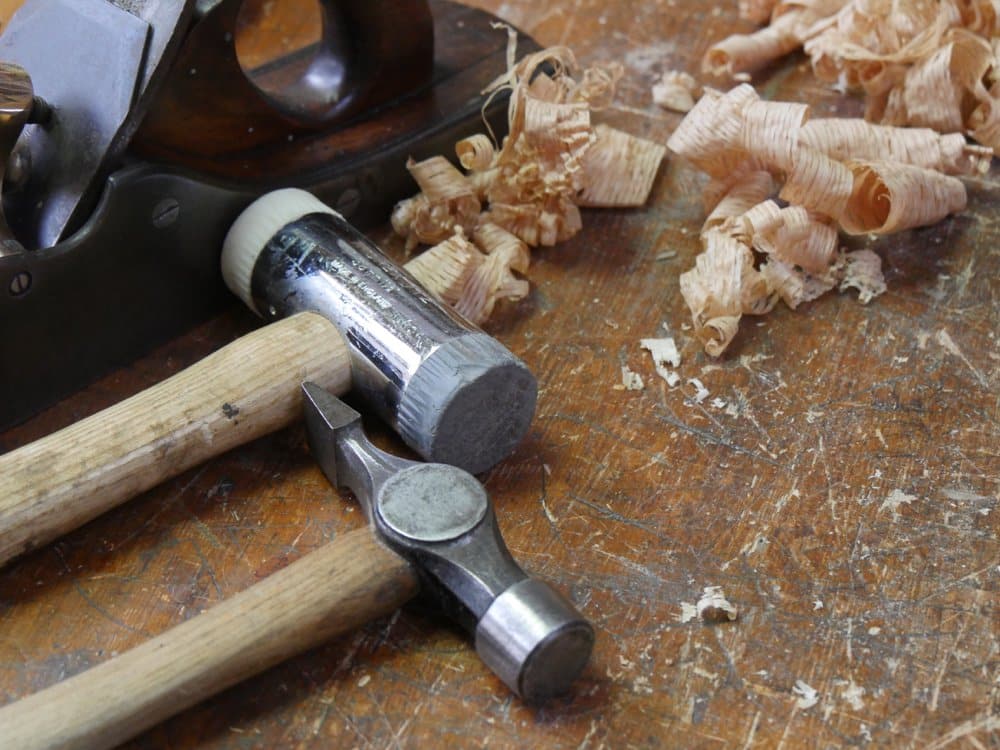


This is the method I prefer for setting my steel block planes and wooden jacks. It always works ! As for engineers my father in law was a jewellers chainmaker who made all his own machines, and to get to the final working set of a milling machine or lathe tool his final adjustments were always little pops with the heel of his hand !!
Great article – always wondered how to set the blade on my old infill smoothing plane (it is a “user made” mini-version of a panel plane) and now I know.
I hope all this valuable plane-related information from your blog is going to appear collected together in a book some day.
Paul
Ahhh, but here is one mechanical engineer at least who just loves tap adjusting. Tapping the iron for a deeper cut is obvious, but utilizing inertia to withdraw the iron is just beautiful physics! I often prefer my Mathieson above the regular Stanleys. In any case, simplicity is a very sound engineering principle.
Has a vintage infill panel plane worth hundreds of dollars.
Complains that spending $25 on a suitable plane hammer is snobby and a waste of money.
Ugh.
I can’t agree with this Andrew and don’t read Paul’s comments as you do. I don’t have a vitage infill plane but I’d like one just because I think it a thing of beauty. That is not snobbery, at least I don’t think so. I’ve used a Stanley 3 since my mother bought it for my 14th birthday. I’ve just refurbished a 4 and a 5 a half. I do have an expensive modern 4 and it is excellent, and beautifully finished. But it is no better or worse than the other Bailey planes I own. I can see in my own life how I have been beguiled into buying lot of expensive stuff all of which is good for purpose. But encouraged by Paul to take charge of my tools I realize I have spent a lot of money that I could have saved. More important I have felt a weight lifting from my shoulders. Now I’m sharpening tools properly again and using them more skillfully than I have for many a year. Iam getting great pleasure from this but the most important observation is that I now feel in charge again. I remember seeing work at Sothery’s by some of Makepeace’s students. Work done with a Leigh gig humbled me (I didn’t know how it had been done at the time). But it left me wanting too: there was no warmth, no real feel for wood. Reading David Pye on the workmanship of risk and the workmanship of certainly helped me realize that there are aesthetic values involved here too. Watching Paul make a simple dovetail as against a jig cut dovetail or even a Woodrat cut dovetail just didn’t compare. For me it was like seeing a Beethoven String Qtt expressed in wood. Not even Rick Wakeman can compare with the Takas, the Tokyo, the Amadeus. Doesn’t make what he does bad or second rate but the special pleasure string quartets give me is just that, special. I feel that about Paul’s work. I spent most of my working life teaching, mostly not woodwork, and I loved it. I stayed teaching right up to retirement where I could have become a head or an educational psychologist. I loved teaching. I get a huge buzz from watching Paul teach. He’s addicted to it and what an addiction. He is also very good at it. Something he has seldom if ever mentioned is how many times he has heard people say they’d like to work in wood but can’t afford the investment of a couple of thousand pounds to set up a workshop. Well perhaps he hasn’t heard such comments but I hear them and I hear people say they are too old to learn and….. My oldest reqular pupil at the moment is 67 who had never touched a musical instrument until he was turned 60. I’ve seen this so many times. I have another music pupil in her 70s who I started off and who is now largely teaching herself. Paul has so much to offer like this. I hold him in huge respect. I do rather regret a lot of purchases that he would have advised me against and which I now realize were not sensible. Wood machining is not woodworking: it does not develop a feel for wood and the results are clinical, precise, and lifeless. Well that’s my view. Now I have to find a way to sell a lot of expensive gear to make room so I can get on with some proper and deeply pleasing woodwork.
Lots of probably fair points but this article is about neither dovetails, Leigh jigs, methods of handwork or Paul Sellers as a teacher in general.
Most people who will use a hammer to tap adjust their plane iron will be trying to use a wooden bodied plane, presumably a rehabbed find (not a pricey new model like one from Matt Bickford, Old Street, et al. , if they are reading this 101-type article). The reality of using the hammer suggested in this article to adjust these will result in unsightly dents (“French” marks, or I suppose “english” marks in this case). This is patently poor advice. Buy a nice wood and brass hammer ($24 Canadian from lee valley for example).
My problem with showing a very expensive infill while bemoaning spending a small fraction of that on the proper adjusting tool is a type of hypocrisy I can’t let go in addressed.
As the defender against the hypocrites you should be armed with or indeed present all the facts if indeed fairness is the true objective. The infil planes cost me less than £20 for the two all those decades ago. Not a massive chunk of change even then. And the hammer I had been advised to tell my audience about a few weeks ago cost £140; a very massive chunk of change for such a limited-use tool. And indeed a steel hammer like the one shown does not damage the irons or the planes any more than softer metal hammers when used sensitively and with skill. Also, did not “the 101-type article” also highly recommend the Thorex 712 with nylon faces for body-shocking aspects of the adjustments and so balance out any possibility of damaging the wood (or the steel for that matter)?
Dear Paul,
I can’t agree with this Andrew and don’t read Paul’s comments as you do. I don’t have a vintage infill plane but I’d like one just because I think it a thing of beauty. That is not snobbery, at least I don’t think so. I’ve used a Stanley 3 since my mother bought it for my 14th birthday. I’ve just refurbished a 4 and a 5 a half. I do have an expensive modern 4 and it is excellent, and beautifully finished. But it is no better or worse than the other Bailey planes I own. I can see in my own life how I have been beguiled into buying lot of expensive stuff all of which is good for purpose. But encouraged by Paul to take charge of my tools I realize I have spent a lot of money that I could have saved. More important I have felt a weight lifting from my shoulders. Now I’m sharpening tools properly again and using them more skill fully than I have for many a year. I am getting great pleasure from this but the most important observation is that I now feel in charge again. I remember seeing work at Sothery’s by some of Makepeace’s students. Work done with a Leigh gig humbled me (I didn’t know how it had been done at the time). But it left me wanting too: there was no warmth, no real feel for wood. Reading David Pye on the workmanship of risk and the workmanship of certainly helped me realize that there are aesthetic values involved here too.
Regards,
Arnold
Dear Paul,
Great article! Always wondered how to set the blade on my old infill smoothing plane (it is a “user made” mini-version of a panel plane) and now I know.
I hope all this valuable plane-related information from your blog is going to appear collected together in a book some day so the next generation will learn from the old methods
Sebastiaan
I had used ball peen hammers (and will again to set knife tangs), but I never saw a cross peen hammer until I dug through my grandfather’s old tool chest a couple years ago. and found one next to the 24″ Siegley transition jointer. A quick wipe-down and a careful exam told me right off the bat that this would work with what you term “tap adjustment”. It’s a Stanley Warrington: “Zada” Polaski didn’t skimp much when he was going to buy one tool for many purposes.
Hi my name is Kai van Eck,
I am a student of the HMC (wood and furniture college)Rotterdam. For my English assignment I have to comment on your blog. I think that the (old) way of adjusting a panel plane is something you need skills for. But if you master it. It is the best way of adjusting your tools because you can make it as sharp as you want. I have never done it myself. And I think it takes me years to master it. Thanks a bunch for explaining how to do it. It will help me in my study because I like to mix the old ways with the new ones. So I can learn both ways.
Kind regards,
Kai van Eck
Dear Paul,
My name is Doreen van den Berg and I am a student of the Hout en Meubel College in Rotterdam (The Netherlands) I have to post on blogs of my English lessons.
I’ve never learnt to use a hammer for install my cutting iron, and I think that this blog will open some eyes by some classmates of mine who also have to post on this blog. This is also the first blog were we can learn from.
Greetings Doreen
Dear Paul,
I am also a student from the Netherlands. Its is funny to see how you can adjust your plane with a hammer i never thought of it and i am definitly going to try it out. Im not kind of a blog reader so i kinda skipped through it, maybe if find the time i will read the whole thing nevertheless thanks for an eye opener
Kind regards,
Mathijs
Dear Paul,
My name is Ronald van Wijk, I am 18 years old and I am living in Werkendam in the Netherlands. I’m following a study for furniture maker at the HMC in Rotterdam.
And I am one of the students who have to look and command at your blog.
I agree 100% with my fellow students it is a new way to change and position your blade of your planer. Maybe our teacher can teach us this as well and shows it to us.
I really liked reading your blog and learned a bit of it.
Good luck in the future and keep up the good work.
Kinds regards,
Ronald van Wijk
Hello Paul,
My name is Rick Zagwijn i’m also a student of the Hmc. I have never seen this method of changing the position of your blade or planer. I think i will try this method the next time i want to flatten my wood! thank you for this blog.
Kind regards,
Rick Zagwijn
Dear Paul,
My name is Arie Nomen. I am a student at the HMC in Rotterdam, The Netherlands. This kind of method of changing the position of the blade is new to me. I like to read stories about methods so I can use those at my own practice. This one is very useful, thank you for this blog.
Kind regards,
Arie Nomen
Hello Paul
The more mechanical adjusting options the more can go wrong. I can understand that statement, but I believe that’s not true in every situation. The two most important adjusting options on a hand plane are the depth adjustment wheel and the lateral adjustment lever. I certainly believe that you can adjust the plane great without them and using your tap method, but it’s far more easy using these adjusters. What makes the depth adjuster very useful in my opinion is the option to adjust the depth while you’re planing. You start planing with the iron fully retracted and while planing you slowly lower the blade and you stop lowering the iron when you are happy with the wood curls. I believe your way works good to, but the ability to adjust the depth while planing is a big improvement.
It sounds as though you are quoting something I said and that I imply non adjusters are better. Not sure why any of this is said here. Also, many Bailey pattern planes are difficult to adjust mid stroke as you are suggesting. Especially is this so for beginners. I wouldn’t want what you are suggesting to be normal plane craft. Even I would find it difficult.
Dear Paul,
I misinterpreted your story a little bit. I thought you meant that planes with adjusters were inferior to planes without, but after reading the blog again I noticed this was not the case.
The mid stroke adjusting is what I have learned at the furniture making school that I attend. That’s the way I learned to adjust my planes and that’s the way I prefer to do it.
I enjoy the content you are making and hope I didn’t annoy you with my comment.
Koen
Dear Paul,
My name is Pauline Tanis and I am a student of the Hout en Meubel College in Rotterdam (The Netherlands) I have to post on blogs for my english teacher.
I’ve never learnt how to install my cutting iron, so i also didn’t know you could use a hammer for that. I think you can learn a lot to people who are learning for furniture making.
kind regards,
Pauline Tanis
Haai Paul,
I always saw my practice teacher applying this method, and it never worked for me. But after reading your blog it stimulated me to try it again. I think it is something you have to try a lot of times before it will work. Because it also can go absolutely wrong. It isn’t careful at al. So at some points I wouldn’t apply this method. I will give it a try
Kind regards,
Beryl
Dear Paul,
First of all, I like your article. I like to see someone still using the old methods.
That panel plane of yours looks very nice. I have never heard of adjusting the depth of cut by using a hammer. I think it takes a lot of practice to adjust the cutting iron very precise. But it is worth to try.
Thank you for the blog.
Bas
Hello Paul,
My name is Jochem and I live in the Netherlands. I am studying to become a wood furniture maker at the HMC in Rotterdam. I’ve never learnt to install my steal cutting iron white a hammer. I have home a wood cutting iron. This one is really old. you need a hammer for install this cutting iron. But you hit the frond or the back site from it to make the iron tied. I like to know how you do it with a steal one.
Kind regards,
Jochem
Dear Paul,
I also am one of the students from The Wood & Furniture College (Hout & Meubilerings College) in Rotterdam.
As many of my fellow students I have never learnt to adjust my plane by using a hammer. We have learnt to use the fore knob to adjust our plane.
If I am honest, I am not the greatest when it comes to the shaving aspect. I think that could certainly be due to also not being a star at adjusting my plane. Nevertheless I think it is very interesting to read about ways to adjust a plane.
And maybe this technique will help me in the future!
Kind regards,
Samira Brussé
Dear Paul,
My name is Anna van Noppen and I am nineteen years old . I study Furniture maker at HMC in Rotterdam.
Great article and pictures! I have never learnt to adjust my plane by using a hammer, such a good idea. I think your very inspiring for us as beginner furniture makers. Thanks for sharing your idea.
Kind regards,
Anna
Hello Paul,
My name is Rosanne and I am eighteen years old. I study furniture making at the HMC in Rotterdam. In my first year at school I had to do an exercise with my own wood planer, I found it very difficult to get nice wood curls of my piece of wood. I learned how to adjust it, and now I love working with this tool.
Nice article, very helpful.
Kind regards,
Rosanne
Dear Paul,
My name is Perry van Dam, i follow a studie to become a furniture maker in Rotterdam. The first year of our studie we have learned how to use hand tools but i have never learned to install my steal cutting iron with a hammer. Reading your story was definitely a learning experience for me.
Kind regards
Perry
Dear Paul,
My name is Rens de Kuyper. I am a student at the HMC in Rotterdam, The Netherlands. This kind of method of changing the position of the blade is total new to me. I never thinked like this before, I like to read stories about methods so I can use those at my own and practice with it . This one is very useful, thank you for this blog.
Kind regards,
Rens de Kuyper
Dear Paul,
My name is Roy, I am 20 years old and I am living in Heenvliet in the Netherlands. I’m studying furniture maker ate the wood and furniture college at Rotterdam. Your blog is very instructive. And I find it cool that you with craft tool works. Good luck in the future.
Kind regards,
Roy Snijders
Dear Paul,
For me it is a new way of setting a planers blade. It’s quite interesting to see and maybe more easy to handle then the way we have learnt it. I am looking forward for asking my teacher more information about it. I will follow your blogs in the future because I think I can learn of them.
Thank you for the information about this.
Yours sincerely,
Marijn Koene
Dear Paul,
My name is Brian Otte . I am studying to become a wood furniture maker at the HMC in Rotterdam. In the first of my study I learned how to use hand tools. But I never learned to install my steal cutting iron with a hammer.
Thank you a lot for explaining how to do it. Maybe it will help me in the future.
Kind regards,
Brian Otte
Dear Paul,
My name is Quinten van Dommelen, I’m also a student at het HMC in the Netherlands. Our English teacher gave us the assignment to read blogs and yours is one of them.
I never learned to use a hammer for install my cutting iron, we only learned how to do it using a knob. I will try doing it this way sometime. I liked the post it was really detailed
Kind Regards,
Quinten
Dear Paul,
Thank you for your blog, I enjoyed it. It is easy too read and i did understand all of it. I am one of the student at the HMC in the Netherlands. I’m in my third year and I remember the first lesson we had at this school. Namely about the panel planes. It was nothing special compared to your blog. I have learned from your blog and I keep your blog in mind the next time I adjust my planel plane.
I hope more people will read your blog and learn from it
kind regards,
Phyllis de Oude
Dear Paul,
My name is Dustin Franken, I am 18 years old and I live in the Netherlands. First off all I like the way you work with hand tools. I have never seen this method of changing the position of your blade or planer. I think it is a good idea to try this by my own. Keep up the good work!
Kind of regards,
Dustin Franken
Dear Paul,
My name is Mees Deppe and I’m also a student from the HMC in Rotterdam. our english teacher, Mr. Sprakelaar, gave us an assignment to comment on a variety of blogs to improve our english reading and writing.
i liked reading your blog, because the planes we use at our school use a different method. They can be adjusted with a little turning knob. so now i know how to adjust a ”knobless” panel plane.
kind regards,
Mees Deppe
Ps: where did you get your plane? i’ve never really seen one with either a square handle at the front or wood inbetween the metal side parts.
Dear Paul,
My name is Joël van der Burgh, student at the HMC in Rotterdam.
I like the way you set your plane. It is an other methode than I have learned at school. But I think it is good way to set your tool well. Maybe a better way because of the personal touch with the hammer.
Kind regards,
Joël
Dear Paul,
My name is Jouri and I live in the Netherlands. I am studying to become a wood and furniture maker at the HMC in Rotterdam.
I would like to buy some panel planes because neighbours and friends ask me to build or repair some things and they would be useful. I also think they are a thing that should be preserved.
Actually lately I used my Stanley bailey planer a lot, just to shave the sharpness off the edges of wooden planks.
This is great example of how to adjust your panel planer but sadly I do not have the time to do this because adjusting a router takes too much time just to get rid of the sharpness of a few planks.
Yours sincerely,
Jouri
Dear Dale,
My name is Mik Witlox and I am studying to become a wood furniture maker at the HMC in Rotterdam. I live in Roosendaal in The Netherlands.
I think this is an amazing blog with very clear pictures where we can learn from. I like to read blogs about some methods how we can use some hand tools. I hope more people will read your blog!
Keep up the good work,
Mik Witlox
Dear Paul,
I am Danielle de Ruijter and I am also a student at the HMC in Rotterdam. I is a new way to change and position your blade of your planer. I think that we would try this method the next time. It was a great blog.
Kind regards,
Danielle de Ruijter
Dear Paul,
My name is Waylon, and I’m an aspiring furniture builder from the Netherlands.
A couple of months ago I got my hands on some gear that my father inherited from my grandfather, along with many other tools, there was also a fixed block plane like this one! I was intrigued to see this as I was Always used to a block plane that was more ‘precisely’ adjustable by using small levers or buttons that were on the plane. After looking into it some more I found that it was actually a really accurate tool, and I can’t wait to start using it more often.
This piece really helped me as to how I should accurately adjust my block plane, and I thank you for that!
Kind regards,
Waylon
Dear Paul,
My name is Derk and I live in The Netherlands. Here I’m studying to be a wood and furniture maker at the HMC. For the English lesson we are to comment on your blog. On our school we haven’t learned to set the plane with a hammer. It nice to read new methods. At home a have a plane from Stanley. It works good but I stele is mate from plastic. When this plane damage I will buy a knew one with a wood stele. I thing you have better grip then!!!
Your blog was interesting!!!
Derk